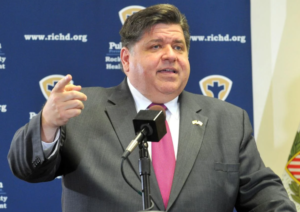If it hadn’t been for the salt in the soils beneath his farm near Hotchkiss, Colorado, Tom Kay likely would not have been able to fully irrigate his corn field this past summer. Because he has salty soils, Kay was able to get government assistance to replace an old flood irrigation system with a center-pivot sprinkler system several years ago.
Sprinklers place water more precisely where the crop needs it, so less water soaks below the root zone or runs off the fields. That means less salt from the soil gets carried into the Gunnison River and, subsequently, the Colorado River. Salty irrigation water causes crop losses downstream, which is why government money is available to do things like help Kay buy sprinklers.
Since 1974, the Colorado River Basin Salinity Control Program has spent tens of millions of dollars each year to reduce salt levels in the Colorado River. It has succeeded in dropping salt levels enough to lower annual economic damages from salt loading by about 38 percent, although damages are still estimated to exceed $350 million.
The salinity control program – part of the larger Environmental Quality Incentives Program (EQIP) managed by the U.S. Department of Agriculture – usually covers around 75 percent of the cost of upgrades such as Kay’s center-pivot system. It actually wasn’t designed to help upstream farmers like him weather drought. But in this case, that is exactly what it has done.
Despite having the good fortune to be on a ditch with senior water rights on the Gunnison River, Kay’s portion of the ditch flows this past summer would not have been enough for him to irrigate a reasonable crop using his old flood system. With his sprinkler system, however, Kay was able to stockpile his ditch water in a small regulating reservoir (which he paid for himself) and then meter out what his corn needed through the sprinklers. He also fallowed a significant portion of his ground.
His reduced supply of water went exactly where it was needed, without seeping out of a dirt ditch on the way, and Kay was able to get more productivity out of each drop – ultimately resulting in one of his best-ever harvests.
Recently, policymakers in the states that share the Colorado River have made headlines for their progress toward developing a drought contingency plan. This plan is intended to keep water levels in the river’s two major reservoirs, lakes Mead and Powell, from falling too low to keep water flowing to all the people and farms that rely on it. Within Colorado and the other upstream states, the plan also seeks to preserve the ability to produce hydropower at Glen Canyon Dam and fulfill legal obligations to the downstream states.
There is significant concern that water use cuts may be required if ongoing drought makes it difficult to keep honoring those obligations. Regional water leaders have strongly advocated that any use cuts to protect reservoir levels should be voluntary, temporary and paid for.
This matters to farmers such as Kay, because they don’t want to be legally required to cut their water use. It also matters to communities like Hotchkiss, because their economies depend on farms using water to grow crops. So a drought contingency plan that prevents a crisis in the big reservoirs and avoids legally required water use cuts would be good for Kay and good for Hotchkiss, as well as for many others in Colorado and the rest of the upstream states.
However, what about when water delivery cuts are mandated by nature rather than laws and policies? When the snow doesn’t come, and you aren’t downstream from a big reservoir, or your reservoir is already tapped out, you sometimes have to make do with less, regardless of how good your water rights are or what the policy documents say. That was the case for many irrigators this past year, and is likely to be the case more often in the future as temperatures continue to warm.
As policymakers are working to keep Lake Powell and Lake Mead functioning, it would be worth sparing some time to also think about the programs supporting drought resilience in headwaters communities, and how to make them more effective.
The views expressed in this article belong to the author and do not necessarily reflect the editorial policy of Water Deeply.
When there is simply less water to go around, infrastructure investments such as the cost-share program that helped Kay buy his sprinklers can make the difference between viability and non-viability for farms and ranches and their rural communities. There are lots of scattered programs that can help with this, some focused on water quality and habitat improvements, and others focused on irrigation efficiency. They’ve brought millions of dollars to rural communities and done a lot of good. But some programs have also suffered from excessive red tape and poor planning.
This article originally appeared on Water Deeply. You can find the original here. For important news about water issues and the American West, you can sign up to the Water email list.





Be First to Comment